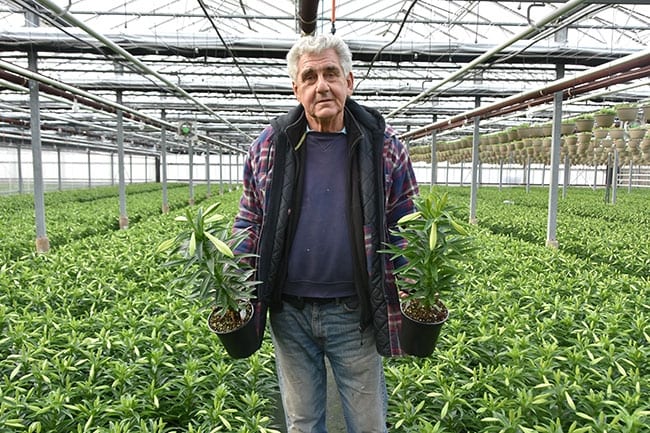Peter Van Beurden stands among his crop of Easter lilies at Westland Greenhouses. Even without fungicides, this lily crop has excellent roots. Easter lily production has declined in the last few years but it is still one of the top five potted crops in terms of sales. 10 million Easter lily bulbs were shipped this past season. In my opinion, the major drop in sales is due to the extra cost of production with minimal increase in selling price. Low profit margins lead to the lack of marketing programs to promote Easter lily sales, so many growers stop producing them and exposure to the lily crop dies down. The purpose of this article is: To point out to buyers – whether broker or chain store – that they should pay the costs so growers can have the margin to grow this crop again. If higher volumes are sold, input costs will be stabilized because higher volumes lead to lower input costs. To share a few pointers from my experience in growing this crop for 40 years. They may (or more likely will) increase the return on your investment, and you can look forward to growing a crop with lots of rejuvenated potential. Varieties The cultivar ‘Ace’ was the predominant choice between 1960 and 1970. Since 1980, ‘Nellie White’ has been the primary cultivar and continues to the present. Another option is new cultivar ‘Chilly White’, which has a smaller bulb circumference but can produce high bud counts. Production-wise, Ace takes the longest time to produce in the greenhouse because it has more leaves to unfold but potentially more buds than Nellie White. The new cultivar Chilly White take less time to produce with its smaller buds. As with any genus, more and smaller flowers lead to faster production time compared to larger or double flowers of the same genus. Production pointers Flower induction – Flower induction for lilies occurs when daylengths are longer than night. In nature, it occurs in June. This can be overcome with a cooling period of six weeks, placing moist bulbs at an optimum temperature […]






